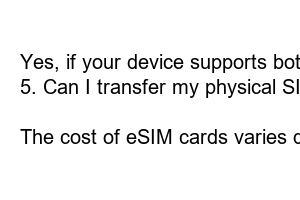유심 이심 차이
Title: Understanding the Essential Difference Between SIM Card and eSIM Card
Introduction:
In today’s fast-paced digital world, staying connected is crucial. Whether it’s for work or personal use, having a reliable and efficient mobile network connection is paramount. This is where SIM cards and eSIM cards come into play. While both serve the same purpose of connecting your smartphone to a mobile network, there are important differences between the two that you need to know.
1. What is a SIM Card?
A SIM card, short for Subscriber Identity Module, is a small removable card that is inserted into a mobile device. It stores data that identifies your device to the network, allowing you to make calls, send messages, and access mobile data.
2. What is an eSIM Card?
An eSIM card, or embedded SIM card, is a virtual SIM card embedded within your device. Unlike a physical SIM card, it does not require a physical swap or insertion. Instead, it allows you to switch between different networks and data plans by simply downloading the necessary settings.
3. Physical vs. Digital
While a SIM card is a physical card that requires manual installation and swapping to switch between devices, an eSIM card eliminates the need for physical swapping. This makes eSIMs particularly useful for dual SIM devices, such as smartphones or tablets, where you can switch seamlessly between multiple networks.
4. Flexibility and Convenience
Traditional SIM cards typically offer limited storage for contacts and messages, whereas eSIMs can store multiple profiles, making it easier to switch between different plans or networks without the hassle of physically changing the card.
5. Global Coverage and Roaming
With a physical SIM card, it’s necessary to purchase a local one when traveling abroad to ensure connectivity. However, eSIM technology enables users to access global networks without the need for buying and inserting a new card, making it a more convenient option for frequent travelers.
6. Security and Safety
eSIMs offer enhanced security features. With physical SIM cards, they can be easily lost or stolen, potentially compromising personal data and exposing you to identity theft. In contrast, being embedded within the device, eSIMs are significantly more secure.
Summary:
In summary, while both SIM cards and eSIM cards serve the purpose of connecting your device to a mobile network, eSIMs offer greater flexibility, convenience, and security. With their ability to store multiple profiles and access global networks without physical changes, eSIM cards are becoming the preferred choice for many smartphone users. Embracing this technology ensures a seamless mobile experience and allows you to stay connected no matter where you are.
FAQs:
1. Can I use eSIM technology on any device?
eSIM technology is becoming more common, but not all devices support it. Check with the manufacturer or your service provider to confirm if your device is eSIM compatible.
2. Can I store multiple eSIM profiles on my device?
Yes, most eSIM-enabled devices allow you to store and switch between different eSIM profiles, providing the flexibility to use multiple networks or plans.
3. How do I download eSIM profiles?
To download eSIM profiles, you can usually do it directly from your device’s settings menu or through an app provided by your service provider.
4. Can I switch back to a physical SIM card if I’m using an eSIM?
Yes, if your device supports both eSIM and physical SIM cards, you can switch between the two based on your preferences or requirements.
5. Can I transfer my physical SIM card contacts to an eSIM?
Yes, it is usually possible to transfer your contacts from a physical SIM card to an eSIM. Check your device’s settings or contact your service provider for guidance on how to do this.
6. Are eSIM cards more expensive?
The cost of eSIM cards varies depending on your service provider. It’s always best to compare prices and plans to find the most suitable option for your needs.

